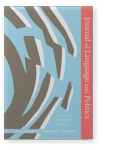David Pujante
List of John Benjamins publications for which David Pujante plays a role.
2020 ‘Letters to Lucilius’ and death: A self-help book written by Seneca Discourses on the Edges of Life, Salvador, Vicent †, Adéla Kotátková and Ignasi Clemente (eds.), pp. 113–124 | Chapter
Moral Letters to Lucilius is a highly modern work in terms of both its generic complexity and its approach, which resembles a self-help treatise written in the twenty-first century. Seneca bases his letters on stoic approaches that may be very useful to today’s society, which lives… read more
2017 Chapter 3. The discursive construction of reality in the context of rhetoric: Constructivist rhetoric Developing New Identities in Social Conflicts: Constructivist perspectives, Morales-López, Esperanza and Alan Floyd (eds.), pp. 41–66 | Chapter
In this chapter, I reflect on the rhetorical origins of the constructivist tradition and its current revival in this latter discipline. I begin with a brief history of the evolution of rhetorical thinking from its origin in antiquity, considering its subsequent conversion into a mere treatise on… read more
2017 Chapter 5. I am and I am not Charlie: The discursive conflict surrounding the attack on Charlie Hebdo Developing New Identities in Social Conflicts: Constructivist perspectives, Morales-López, Esperanza and Alan Floyd (eds.), pp. 83–106 | Chapter
In this paper, I provide a theoretical and analytical approach that seeks to explain cases in which the same events can spark contrasting discourses, and therefore serious conflicts, as well as radical disagreements between social groups.
As an example of one such situation, I have… read more
2017 Chapter 11. Discourses of social movements in Southern Europe: The slogans of 15M Developing New Identities in Social Conflicts: Constructivist perspectives, Morales-López, Esperanza and Alan Floyd (eds.), pp. 227–248 | Chapter
In this chapter, we analyse the 15M social movement, which occupied the public squares of Spain’s large cities on 15 May 2011 (hence its name of the 15M or the indignados movement). This group emerged in the wake of the anti-austerity movements in Iceland and Greece, and the Arab Spring. The main… read more
2008 A political action against popular opinion: Aznar’s final speech before the Spanish Parliament justifying the war in Iraq (December 2003) Journal of Language and Politics 7:1, pp. 71–98 | Article
This paper analyses the last speech delivered in the Spanish Parliament (on 2 December 2003) by President Aznar, in which he attempts to discursively uphold the reasons for his decision to support Bushs Administration (although with a small number of troops), and prove his interpretation of events. read more


